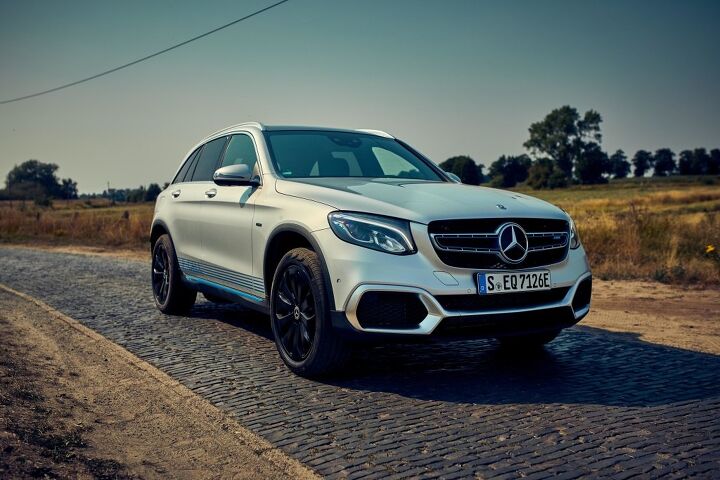Invisible Markets: Mercedes-Benz Launches Hydrogen-powered GLC F-Cell

Mercedes-Benz says it has begun deliveries of the GLC F-Cell, a battery-electric vehicle that can run on hydrogen or a stored electrical charge. That would make it the most sensible hydrogen vehicle currently in existence, which isn’t saying much.
At any rate, it doesn’t really matter because you’ll probably never see one.
The GLC F-Cell is currently bound for government agencies in Germany, likely to be utilized for green posturing. After that, it rolls out to select corporate fleets before becoming available, as a rental, to Germans in highly specific markets — you know, the scant few with hydrogen infrastructures already in place.
We’re not exactly crippled to learn we’ll never have access to another fuel cell vehicle, but it’s a shame Daimler is going to leave those absolutely gorgeous 80s-era graphics emblazoned across the doors in Europe.
Mercedes first showcased the fuel-cell SUV at the Frankfurt Motor Show last year. Intended as a followup to the B-Class F-Cell — which is now almost a decade old — Benz claims its holding tanks is sufficient for 267 miles of hydrogen-only range, or just under 300 miles on a fully charged battery, using the NEDC test cycle. While it’s nice to see Daimler continuing to progress as a member of Hydrogen Mobility Europe, it seems like a pointless waste of the EU’s funds, given the complete absence of demand for these cars among the general public.
Still, the automaker isn’t giving up on the technology. As part of its joint venture with H2 Mobility, Mercedes says it wants to double the number of hydrogen fueling stations in Germany by the end of 2019. Unfortunately, this only means an additional 50 stations — explaining why the company is being so selective about the GLC F-Cell’s availability.
[Images: Mercedes-Benz]

A staunch consumer advocate tracking industry trends and regulation. Before joining TTAC, Matt spent a decade working for marketing and research firms based in NYC. Clients included several of the world’s largest automakers, global tire brands, and aftermarket part suppliers. Dissatisfied with the corporate world and resentful of having to wear suits everyday, he pivoted to writing about cars. Since then, that man has become an ardent supporter of the right-to-repair movement, been interviewed on the auto industry by national radio broadcasts, driven more rental cars than anyone ever should, participated in amateur rallying events, and received the requisite minimum training as sanctioned by the SCCA. Handy with a wrench, Matt grew up surrounded by Detroit auto workers and managed to get a pizza delivery job before he was legally eligible. He later found himself driving box trucks through Manhattan, guaranteeing future sympathy for actual truckers. He continues to conduct research pertaining to the automotive sector as an independent contractor and has since moved back to his native Michigan, closer to where the cars are born. A contrarian, Matt claims to prefer understeer — stating that front and all-wheel drive vehicles cater best to his driving style.
More by Matt Posky
Latest Car Reviews
Read moreLatest Product Reviews
Read moreRecent Comments
- Dartman https://apnews.com/article/artificial-intelligence-fighter-jets-air-force-6a1100c96a73ca9b7f41cbd6a2753fdaAutonomous/Ai is here now. The question is implementation and acceptance.
- FreedMike If Dodge were smart - and I don't think they are - they'd spend their money refreshing and reworking the Durango (which I think is entering model year 3,221), versus going down the same "stuff 'em full of motor and give 'em cool new paint options" path. That's the approach they used with the Charger and Challenger, and both those models are dead. The Durango is still a strong product in a strong market; why not keep it fresher?
- Bill Wade I was driving a new Subaru a few weeks ago on I-10 near Tucson and it suddenly decided to slam on the brakes from a tumbleweed blowing across the highway. I just about had a heart attack while it nearly threw my mom through the windshield and dumped our grocery bags all over the place. It seems like a bad idea to me, the tech isn't ready.
- FreedMike I don't get the business case for these plug-in hybrid Jeep off roaders. They're a LOT more expensive (almost fourteen grand for the four-door Wrangler) and still get lousy MPG. They're certainly quick, but the last thing the Wrangler - one of the most obtuse-handling vehicles you can buy - needs is MOOOAAAARRRR POWER. In my neck of the woods, where off-road vehicles are big, the only 4Xe models I see of the wrangler wear fleet (rental) plates. What's the point? Wrangler sales have taken a massive plunge the last few years - why doesn't Jeep focus on affordability and value versus tech that only a very small part of its' buyer base would appreciate?
- Bill Wade I think about my dealer who was clueless about uConnect updates and still can't fix station presets disappearing and the manufacturers want me to trust them and their dealers to address any self driving concerns when they can't fix a simple radio?Right.





































Comments
Join the conversation
Hydrogen is fuel of the future - in fusion reactors. There's a political market enamored by this tech's circus trick of pure water coming out the exhaust pipe. The peanut gallery falls for it every time. Suckers.
My first car was a GLC. I wish I still had it. Mazda, Mercedes, same thing, right?